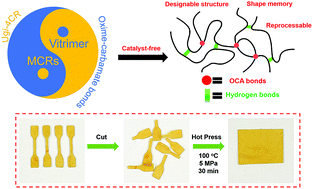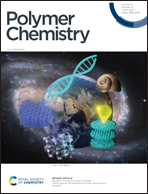Preparation of multi-functional polyamide vitrimers via the Ugi four-component polymerization and oxime-promoted transcarbamoylation reaction†
Abstract
In order to control the relationship between the polymer structure and performance, multi-component reactions (MCRs) have been used to adjust the properties of polymers due to their high atom utilization and structural designability. As a newly emerging type of material, vitrimers combine the advantages of both thermoplastics and thermosets. Therefore, it would be an exciting idea if the advantages of MCRs can be used to prepare vitrimers. In this work, for the first time, the Ugi four-component reaction (Ugi-4CR) is utilized to fabricate polyamide vitrimers (Dx-Poly). Among the resultant Dx-Poly, D400-Poly exhibits the best mechanical properties (stress = 8.75 MPa and strain = 255%) as well as excellent reprocessing performance. Additionally, these materials also have self-healing and shape memory properties. The use of the Ugi-4CR to prepare polyamide vitrimers will not only expand the scope of application of MCRs to the materials field, but also offer new ideas for the preparation of structurally designable vitrimers, which makes the “old” organic reaction gain “new” vitality in the field of materials.



 Please wait while we load your content...
Please wait while we load your content...